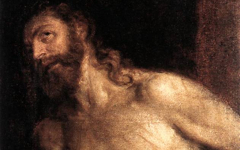Titian’s Transfiguration (1560-65)
Artists sometimes depict themselves as an extraneous figure, often in the foreground and not part of the written story on which the image is based. In this print after a painting by Titian of The Transfiguration all but one of the figures surrounding Christ are part of the Biblical story of the Transfiguration. Only the boy is not.
Click next thumbnail to continue
Who is the boy? The boy’s hand, lit from the front unlike the others, appears as though it is placed on the flat surface of the image itself.
Click next thumbnail to continue
This is even more evident in the original painting where the boy’s hand clearly casts a shadow on the surface beneath it (in reverse, not being a print, on the right-hand side). Thus, once again, as in Ghirlandaio’s Portrait of an Old Man and Boy, the child personifies the “artist” making the art. Here the boy’s hand and shoulder are so large that it is not even clear whether they are firmly behind the apostle’s head below his elbow as they should be (if he were part of the scene) or in front of it.
Click next thumbnail to continue
With the boy as "the artist" painting the image, there are five other figures, all of whom to some extent resemble the bearded Titian. One scholar has even noted that Titian painted more figures with beards than would seem natural.1
Click next thumbnail to continue
Another easy observation for the beginner is the dagger attached to an apostle’s belt. It points directly to Titian’s name in the lower right hand corner as though the dagger were the artist’s attribute. Daggers, as demonstrated in other articles in Brush and Palette, often symbolize paintbrushes which its placement here, next to the artist’s name, strongly suggests.
See conclusion below
Figures like the boy who are not part of the narrative are exactly the kind of compositional problem by a great master that you should look out for: they are never an error or mere whim as conventional perception often presumes but a key to the artist's meaning. Their peers would have understood these inconsistencies immediately and still do.
Engravings after paintings were often the main means by which a Renaissance or Baroque artist might see the work of another great master, especially if they did not travel when young. Thus the importance of prints to the development of art is far greater than we often imagine. They are still helpful for us today, often giving us a better idea of what the forms in the painting once looked like than the now-darkened originals. Titian’s Transfiguration is a case in point.
More Works by Titian
Notes:
1. Katherine. T. Brown, The Painter’s Reflection: Self-portraiture in Renaissance Venice 1458-1625 (Milan: Leo S. Olschki) 2000, p. 79
Original Publication Date on EPPH: 01 Jun 2010. | Updated: 0. © Simon Abrahams. Articles on this site are the copyright of Simon Abrahams. To use copyrighted material in print or other media for purposes beyond 'fair use', you must obtain permission from the copyright owner. Websites may link to this page without permission (please do) but may not reproduce the material on their own site without crediting Simon Abrahams and EPPH.








